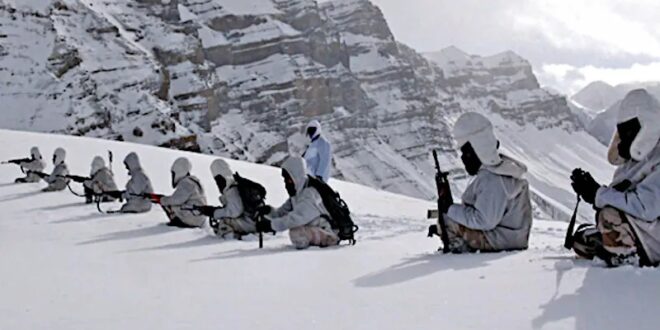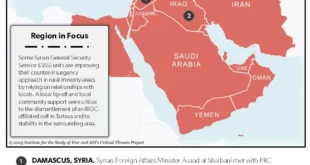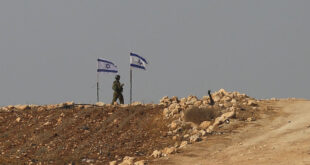India grappled with serious security and domestic challenges this year. Military tensions with China showed no signs of easing, a deadly second wave of the coronavirus pandemic devastated India and the biggest farmers protest in decades challenged Prime Minister Narendra Modi’s authority.
The Asian giants, India and China, ended their most serious confrontation in decades in February by pulling back troops from a disputed border stretch in Ladakh.
But their frontier in the Himalayas remains a dangerous flashpoint as thousands of troops hunker down for a second winter at several other contested points.
Thirteen rounds of talks held between their military commanders to resolve differences hit a stalemate in October with both sides blaming each other for the impasse. China accused India of insisting on “unreasonable and unrealistic demands,” while India said the Chinese side “could not provide any forward-looking proposals.”
The result has been a significant military buildup along the Himalayan frontier.
“Both sides have reinforced their positions. China has been amassing troops, quite significantly, building semi-permanent structures and making a show of force along that long boundary with India,” says Harsh Pant, head of the strategic studies program at the Observer Research Foundation in the capital, New Delhi.
India, which had long focused attention on rival Pakistan, is now preparing to counter the security challenge from its bigger and more powerful neighbor. It is building roads and tunnels to move troops and weapons faster along the China frontier.
Indian Foreign Minister Subrahmanyam Jaishankar said last month that relations between the two countries are going through “a particularly bad patch.”
“They [China] have taken a set of actions in violation of agreements for which they still don’t have a credible explanation and that indicates some rethink about where they want to take our relationship, but that’s for them to answer,” he told a panel discussion in Singapore.
As New Delhi prepared to cope with a more assertive China, Prime Minister Modi participated in two summits of the Quad grouping that consists of Australia, India, Japan and the United States. The first was a virtual meeting held by leaders of the four countries in March, the second an in-person summit hosted by U.S. President Joe Biden in Washington in September. The meetings were an effort to reinvigorate the grouping that is seen as a counter to China’s growing power.
“India has woken up in ways that are quite dramatic. Now India is responding in kind to China not only ratcheting up its troops along the border, but also taking important decisions like formalizing Quad and being more engaged with the Quad,” says Pant. “New Delhi has made it clear it will not back down.”
Modi, known as India’s strongest leader in decades, also confronted the most serious domestic crises he has faced during his seven-year rule.
Earlier this year, a deadly second wave of the coronavirus pandemic fueled by the delta variant sickened or killed millions just months after Modi had virtually declared victory against the virus. His critics blamed his government for complacency.
Modi and senior leaders held huge election rallies and Hindu devotees congregated for a pilgrimage even as cases of the COVID-19 disease were rising in the world’s second worst-hit country.
Authorities were also blamed for failing to prepare the health infrastructure and a sluggish immunization program that left most people unprotected in the world’s largest vaccine-producing country when the second wave hit. His government struggled to cope.
“You had oxygen shortages, hospitals overwhelmed and this very tragic sight of bodies awash in the River Ganges which people will take a long time to forget, so he did come in for criticism,” says independent political analyst Neerja Chowdhury. “Things just spun out of control and Modi did not come across as being in charge.”
In the months since, the government has moved with speed to vaccinate the country – by October it celebrated the milestone of administering a billion doses and had fully vaccinated more than half its population by the year end.
Tens of thousands of farmers from northern India also mounted a massive challenge to Modi as they camped on highways around New Delhi, leading a year-long protest against market friendly reforms in the agricultural sector.
They withdrew their protest this month only after Modi scrapped the laws. It was a massive victory for the farmers who had wrested a rare concession from a leader who has seldom tolerated a challenge to his authority.
Political analysts say that although the prime minister still remains popular, the “sheen” has worn off. They point out that while the economy is recovering and most restrictions have been lifted allowing the economy to open, millions of poor people continue to deal with the economic devastation caused by the pandemic.
“Apart from the mishandling of COVID, there was lack of jobs, families had to pull their children out of school because they did not have the money; child marriage was on the increase because parents could not look after them. Malnutrition increased among children,” says Chowdhury. “I think we have not felt yet the enormity of what has happened during 2021 and failed to grasp its fallout fully.”
In the year ahead, India’s primary concerns will be coping with a more assertive China and creating livelihoods for millions of people even as the omicron variant of the coronavirus poses new uncertainties in a country where the pandemic has waned in recent months.
 Eurasia Press & News
Eurasia Press & News



